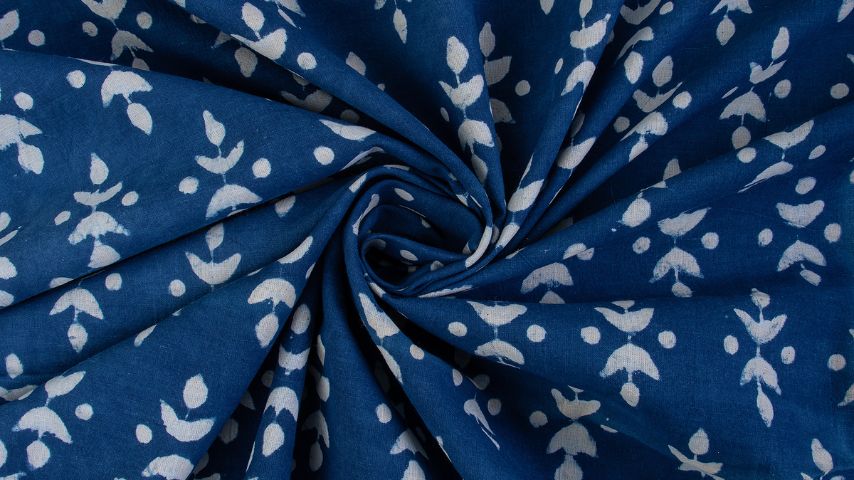
Indigo fabric represents an enduring legacy of natural dyeing, craftsmanship, and cultural significance. Revered for its rich, deep blue hues, indigo fabric has been cherished across civilizations and continents for centuries. From traditional garments to contemporary textiles, indigo fabric continues to inspire artisans and consumers alike, embodying a harmonious blend of history, art, and sustainability.
The Origins of Indigo Fabric
Indigo dyeing is one of the oldest textile traditions in human history, with roots tracing back thousands of years. Ancient civilizations in India, Egypt, and China first discovered the art of extracting indigo dye from plant species like Indigofera tinctoria. Among these, India played a pivotal role as the world’s leading source of indigo, earning the country the nickname “The Land of Indigo.”
Indigo-dyed fabrics were prized for their durability, vibrancy, and symbolism. In many cultures, indigo represented wealth, spirituality, and social status. For example, in Japan, the art of aizome (indigo dyeing) created fabrics for samurai uniforms, symbolizing resilience and purity.
The Process of Indigo Dyeing
Creating indigo fabric is a meticulous and intricate process, deeply rooted in traditional techniques. Unlike synthetic dyes, natural indigo dye is derived from plants through an elaborate extraction process that includes fermenting the plant leaves to produce a deep blue pigment.
Here’s how indigo dyeing typically works:
- Fabric Preparation: The base fabric, often cotton, silk, or linen, is cleaned and pre-treated to enhance dye absorption.
- Indigo Vat Preparation: The indigo pigment is dissolved in water, forming a vat solution that turns yellow-green during fermentation.
- Dyeing the Fabric: The fabric is submerged in the indigo vat, where it absorbs the dye. The fabric oxidizes and takes on its distinctive blue color when exposed to air. This step may be repeated several times for a deeper, richer color.
- Drying and Finishing: Once dyed, the fabric is washed, dried, and often softened to achieve the final product.
This labor-intensive process reflects the artisanal expertise and patience required to produce authentic indigo fabric.
Indigo Fabric Around the World
Indigo fabric holds a special place in the cultural heritage of many regions, each adding its own distinct techniques and patterns:
- India: Known as the birthplace of indigo dyeing, India’s Ajrakh and Bagru prints use natural indigo dyes to create intricate, geometric patterns.
- Japan: Japanese indigo dyeing, or shibori, involves tie-dye techniques to produce intricate patterns, often used in traditional kimonos.
- West Africa: Indigo fabric, known as adire in Nigeria, is created through resist-dyeing methods, often symbolizing community and heritage.
- Europe: Indigo became a staple of European fashion in the form of denim during the 19th century, cementing its role in modern textiles.
Why Indigo Fabric is Unique
Several factors contribute to the enduring popularity of indigo fabric:
- Natural Beauty: The unmistakable richness of indigo blue creates a timeless aesthetic that complements both traditional and contemporary designs.
- Eco-Friendly Appeal: Natural indigo dyeing is a sustainable process that aligns with environmentally conscious practices, avoiding harmful chemicals used in synthetic dyes.
- Versatility: Indigo fabric adapts seamlessly to various applications, including clothing, upholstery, accessories, and art pieces.
- Durability: Indigo-dyed fabrics are known for their ability to retain color and strength over time, making them ideal for everyday use.
Modern Applications of Indigo Fabric
While indigo fabric has ancient origins, its versatility has ensured its relevance in modern design. Today, indigo fabric graces high-fashion collections, interior décor, and even eco-friendly lifestyle products.
Fashion designers incorporate indigo fabric into everything from flowing dresses to rugged denim jeans, highlighting its adaptability across styles and seasons. Home décor enthusiasts favor indigo textiles for cushions, tablecloths, and wall hangings, bringing a touch of natural beauty and heritage to their spaces.
Artisans and independent brands often experiment with indigo dyeing techniques, producing bespoke patterns that blend tradition with innovation. These contemporary interpretations make indigo fabric a sought-after choice for those seeking uniqueness and authenticity.
Preserving the Legacy of Indigo Fabric
The revival of indigo fabric has also sparked efforts to preserve its traditional methods and empower artisan communities. To promote fair trade standards and guarantee that craftspeople are fairly compensated for their labour, numerous organizations and designers collaborate directly with craftsmen.
Moreover, the growing demand for eco-conscious products has elevated the status of natural indigo fabric as a sustainable alternative to synthetic textiles. By choosing indigo fabric, consumers support not only the environment but also the cultural heritage of dyeing traditions.
Caring for Indigo Fabric
To maintain the beauty of indigo fabric, it’s essential to care for it properly:
- Wash in cold water using mild detergent to prevent fading.
- Avoid prolonged exposure to sunlight, which can cause the color to lighten.
- To maintain the integrity of the fabric, hand washing is frequently advised.
Over time, indigo-dyed fabrics develop a unique patina, adding character and charm.
Conclusion
Indigo fabric is more than just a textile—it’s a bridge between ancient craftsmanship and modern sensibilities. Its deep blue hues, artisanal roots, and sustainable appeal make it a timeless choice for those who appreciate beauty with a story.
Whether used in clothing, home décor, or artistic projects, indigo fabric connects us to a rich cultural heritage while offering endless possibilities for creative expression. Explore the world of indigo and experience the magic of this age-old art form, one thread at a time.